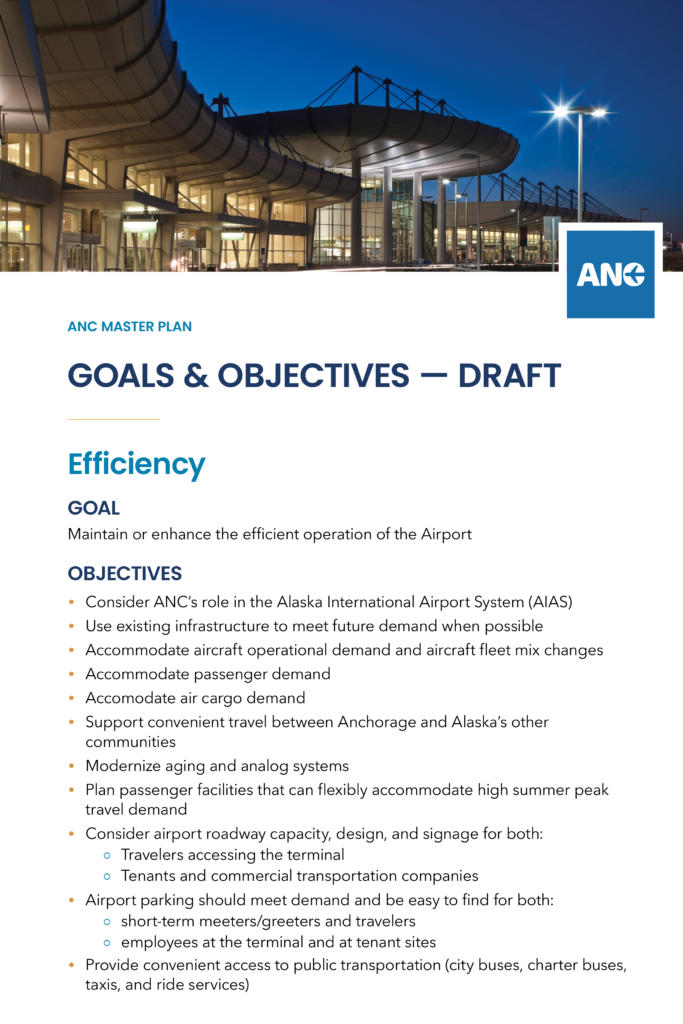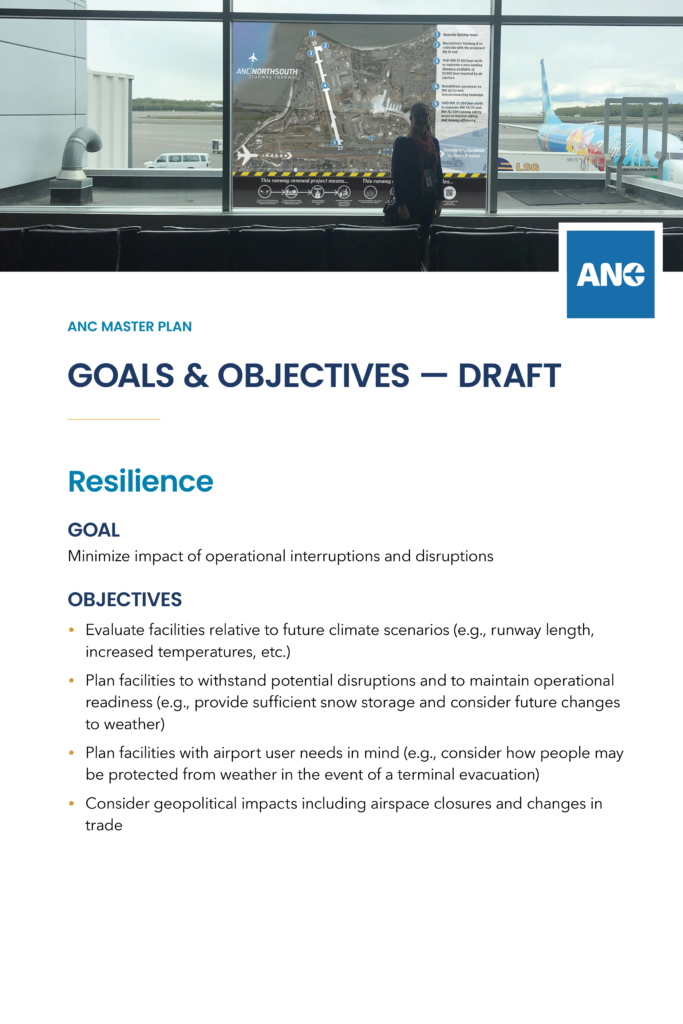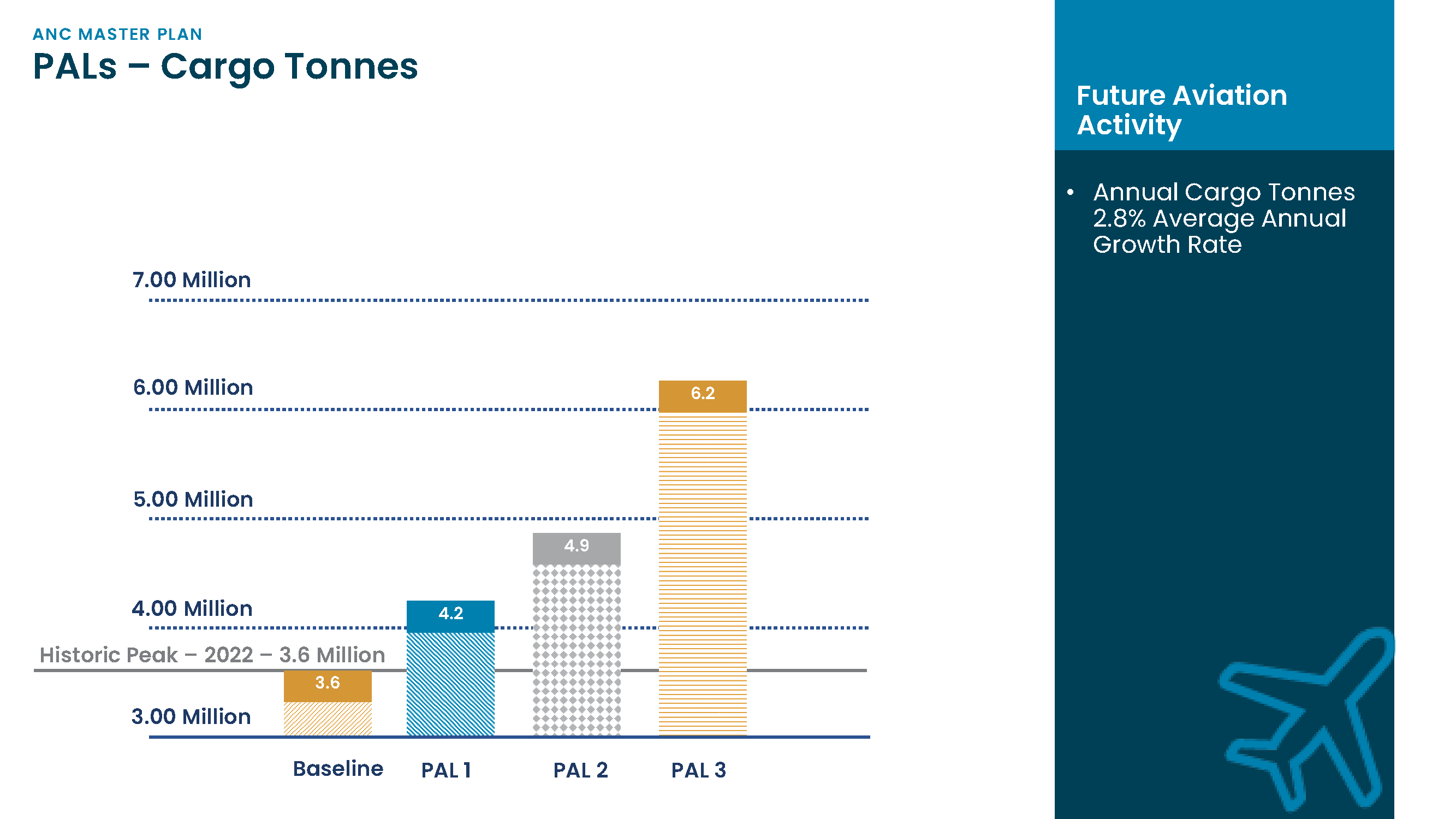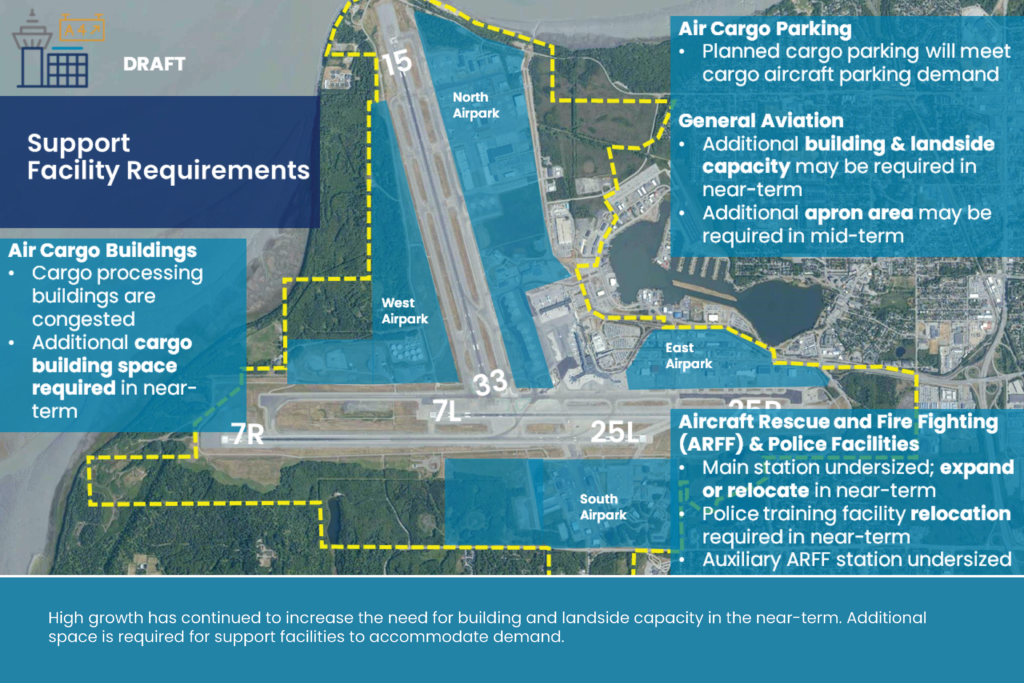Supplemental Information
Welcome to the ANC Master Plan Update – Online Open House supplemental information page. Here find past materials that have been presented at past Public Open Houses for this project.
Goals and Objectives for ANC Master Plan Update
The goals and objectives (G&O) will be used to evaluate alternative actions for meeting the primary purpose of the Master Plan Update: evaluating the best course of action for Airport development to meet future aviation demand.
The following goals were identified at the project’s outset in a staff and airport leadership workshop and are modestly evolved from the prior Master Plan. Project goals are broad statements about what the Airport hopes to achieve through the Master Plan Update process.

Goals and Objectives 1: Safety
Maintain or enhance the safe operation of the Airport
The Master Plan Update will prioritize and consider safety in every aspect of facility planning. The Airport operates safely today, and the Master Plan Update will seek to ensure that the Airport’s safe operation is maintained or enhanced with any recommended development.
Objectives:
- Plan airfield facilities including taxiways and runways that meet established design and operational standards and best industry practices
- Plan to provide safe, secure access to the Air Operations Area
- Plan terminal and landside facilities that meet current safety and security standards and consider the unique needs of Alaska’s operating environment and travelers
The Master Plan Update will prioritize and consider safety in every aspect of facility planning. The Airport operates safely today, and the Master Plan Update will seek to ensure that the Airport’s safe operation is maintained or enhanced with any recommended development.

Goals and Objectives 2: Efficiency
Maintain or enhance the efficient operation of the Airport
The purpose of an airport master plan, as prescribed by FAA, is to plan future development to ensure that the airport can meet future aviation demand. Future demand may include growth in airplane operations or passengers and can also result in changes in airplane operations and passenger behavior. The master plan must consider how these changes will impact the airport and identify development that will enable the airport to continue operating with minimal delays or inconveniences for airport users.
Objectives:
- Consider ANC’s role in the Alaska International Airport System (AIAS)
- Use existing infrastructure to meet future demand when possible
- Accommodate aircraft operational demand and aircraft fleet mix changes
- Accommodate passenger demand
- Support convenient travel between Anchorage and Alaska’s other communities
- Modernize aging and analog systems
- Plan passenger facilities that can flexibly accommodate high summer peak travel demand
- Consider airport roadway capacity, design, and signage for both:
- travelers accessing the terminal
- tenants and commercial transportation companies
- Airport parking should meet demand and be easy to findfor both:
- short-term meeters/greeters
- employees at the terminal and at tenant sites
- Provide convenient access to public transportation (city buses, charter buses, taxis, and ride services)

Goals and Objectives 3: Environmental Awareness
Minimize the impact of airport development through environmental awareness
The Master Plan Update outlines the Airport’s role and responsibilities regarding addressing federal, state, and local environmental regulations. An environmental inventory, as well as high-level analysis of potential environmental impacts of the Airport’s current and future operation and facilities, are undertaken to address this goal.
Objectives:
- Document the airport’s environmental setting
- Seek opportunities to minimize unavoidable environmental impacts
- Consider and minimize noise levels in and around the Airport
- Document the presence of per- and polyfluoroalkyl substances (PFAS) and follow best practices for planned development
- Document opportunities to support energy-efficient equipment, such as electric ground service equipment
- Evaluate growing demand for electric, zero-emission vehicles
- Evaluate infrastructure to provide vehicle charging facilities
- Seek opportunities to enhance the Airport’s energy efficiency and reduce greenhouse gas emissions

Goals and Objectives 4: Fiscal Sustainability
Maintain the long-term fiscal sustainability of the Airport
Fiscal sustainability promotes planning of Airport improvements that allow the Airport to meet future demand affordably. The Master Plan Update includes assessment of the Airport’s financial capacity and will prioritize planned projects based on need and funding opportunity.
Objectives:
- Maximize business through evaluation of revenue generation opportunities
- Consider the cost of planned projects against potential savings (e.g., benefit-cost analysis)
- Plan for land use that enhances lease revenue and supports Airport operations
- Capitalize on opportunities for growth in cargo transfer operations
- Plan facilities that accommodate growing e-commerce and just-in-time shipping by air

Goals and Objectives 5: Land Management
Facilitate long-term Airport development through strategic land management planning
Strategic land management is a process to evaluate the Airport’s existing land and assess the highest and best use for limited land resources. In some cases, the result identifies land assets for targeted development. In other cases, the result identifies land assets for preservation to enable the Airport’s future improvement.
Objectives:
- Document existing land uses and lease durations
- Prioritize land uses that promote and support aviation activity
- Communicate the Airport’s development vision
- Provide clear rationale for lease negotiation and decision-making
- Promote the highest and best use of property with sensitivity to the Airport’s proximity to residential areas
- Consider land use compatibility and development recommendations proposed in the West Anchorage District Plan and MOA 2040 Land Use Plan

Goals and Objectives 6: Communication
Engage stakeholders through open communication
The Airport is a vital transportation and economic asset for the State of Alaska. Its continued operation is essential. The Master Plan Update must document and communicate the Airport’s importance and why its continued improvement is necessary. Likewise, the Master Plan Update is an opportunity for a wide range of stakeholders to participate in the planning process to communicate how they are impacted, both positively and negatively, by the Airport and its operation. This goal helps the Master Plan Update promote effective dialogue between the Airport and stakeholders.
Objectives:
- Build stakeholder trust through regular, open communication and collaboration
- Provide opportunities for stakeholders to engage
- Document how stakeholder feedback is considered in decision-making
- Describe the Airport’s relationship with FAA and the State of Alaska and how the relationship affects the Airport’s decision-making authority

Goals and Objectives 7: Resilience
Minimize impact of operational interruptions and disruptions
Airports can be impacted by both acute and chronic threats such as severe weather, volcanic eruptions, security breaches, sea level rise, and aging infrastructure. The Master Plan should consider how existing facilities can be enhanced to enable recovery that minimizes disruptions and allows the facility to reach appropriate capacities within desired timelines. The Plan should also consider how new facilities can be planned to address future changes and potential challenges to ensure its overall resilience in the long term.
Objectives:
- Evaluate facilities relative to future climate scenarios (e.g., runway length, increased temperatures, etc.)
- Plan facilities to withstand potential disruptions and to maintain operational readiness (e.g., provide sufficient snow storage and consider future changes to weather)
- Plan facilities with airport user needs in mind (e.g., consider how people may be protected from weather in the event of a terminal evacuation)
- Consider geopolitical impacts including airspace closures and changes in trade
Aviation Forecast Summary
The Aviation Forecast was approved by the FAA in September 2023.
1. More takeoffs and landings:
ANC is a busy airport with about 226,000 operations per year. The forecast anticipates 100,000 additional operations in 20 years.
2. More passengers:
ANC is expected to grow from
2.6 million enplanements in 2022 to 4.1 million enplanements in 2042.
3. ANC will continue to be a critical cargo stop:
ANC has an essential role in the Asia-America air cargo market that is unlikely to change in the future.
4. General Aviation will grow slowly:
ANC is expected to see modest general aviation growth in line with other U.S. airports.

Forecast: Cargo & General Aviation
CARGO
Anticipated rate of growth for cargo is 2.8% per year over a 20-year planning period.
What does that mean?
How busy is ANC today?
- ANC was the world’s 3rd busiest cargo airport in 2022 at 3.6 million tonnes
Who is the busiest?
- Hong Kong – 1st globally at 4.2 million tonnes
- Memphis – 2nd globally at 4.1 million tonnes
Who are ANC’s peer airports (in 2022)?
- ANC does not have a cargo peer – ANC is a unique cargo facility with significant landed weight but relatively limited cargo handling and processing.
GENERAL AVIATON
Anticipated rate of growth for general aviation is 1.0% per year over the 20-year planning period. ANC GA activity will grow slightly and follow U.S. trends and GA operations account for about 13% of all operations at ANC today and are expected to decrease to about 11% of operations in 2042.

Forecast: Operations & Passenger Activity
The Aviation Forecast has been approved by the FAA in August 2023.
OPERATIONS
Anticipated rate of growthi is 1.8% per year.
What does this mean? How busy is ANC today?
2022 was ANC’s busiest recent year:
- 226,346 operations
- 26th Busiest US Airport (Source: ACI-NA)
Who is the busiest?
- Busiest US Airport: Atlanta – 707,000 ops
- Seattle ranks 11th – 375,000 ops
Who are ANC’s peer airports (in 2022)?
- A little smaller – MEM (Memphis, TN) – 215,000 ops
- A little larger – SFO (San Francisco, CA) – 266,000 ops
How busy might ANC be in 10 years?
- About as busy as SFO is today.
PASSENGER ACTIVITY
Anticipated Rate of Growth for passenger activity is 2.3% per year over the 20-year planning period.
What does this mean?
How busy is ANC today?
2019 was ANC’s busiest year
- 7 million enplanements
- 59th Busiest US Airport
Who is the busiest?
- Atlanta ranks 1st – 54 million enplanements (2019)
- Seattle ranks 11th – 25 million enplanements (2019)
Who are ANC’s peer airports?
- MKE in Milwaukee, WI is a little busier than ANC
Facility Requirements
Facility requirements identify the scale and type of improvements ANC will need to safely and comfortably accommodate forecast growth for future years. The following facility requirements are associated with planning activity levels that trigger the need for improvements at specific demand levels.

Facility Requirements
Facility requirements identify the scale and type of improvements ANC will need to safely and comfortably accommodate forecast growth for future years. The following facility requirements are associated with planning activity levels that trigger the need for improvements at specific demand levels.
-------------------------------------------------------------
Projections of future facility needs
- What facility improvements are needed for ANC to accommodate forecast growth
Projects when improvements are needed
- Needs for future facilities are tied to Planning Activity Levels, not years
How Are Facility Requirements Derived?
- Analysis based on projected growth in passengers, operations, cargo, and general aviation
- Input from airport staff, tenants, and FAA
- Input from airline personnel and operators
- Facility observations by the technical team
- Consultant analysis based on experience at similar airports

Planning Activity Levels (PALs)
Three planning activity levels (PALs) have been identified, each representing milestones of growth in operations, passengers, cargo, and general aviation. Each PAL triggers required facility upgrades to accommodate growth and capacity. Capacity upgrades to facilities are based on PAL demand levels – not based on a date on a calendar.
Two graphs depict growth scenarios: In the forecast growth scenario, growth occurs according to the forecast, and the example facility upgrade is triggered by the PAL 2 demand. Based on the demonstrated growth rate in this scenario, we know that PAL 2 occurs at the forecast time. However, growth may occur faster or slower than forecast – this is why we use PALs to trigger facility capacity upgrades, not a calendar. For example, in the slower growth scenario, growth occurs more slowly than forecast and the example facility, so PAL 2 demand occurs later than forecast. Therefore, the example facility that is triggered by PAL 2 would not be required until a later time than originally forecast.

PALs - Operations
Operations pictured here represent aircraft takeoffs and landings. Operations are forecast to grow from about 250 thousand per year to more than 325 thousand per year over the planning horizon. ANC's busiest year for operations occurred in 2000 when about 250 thousand takeoffs and landings occurred. Future aviation activity includes annual operations at a 1.8% average annual growth rate.

PALs - Cargo Tonnes
Cargo tonnes pictured here are forecast to grow from about 3.59 million per year to more than 6.18 million per year over the planning horizon. ANC's busiest year for cargo occurred in 2022 when about 3.59 million cargo tonnes passed through the Airport. Future aviation activity at ANC includes Annual Cargo Tonness will have a 2.8% average annual growth rate.

PALs - Emplaned Passengers
Passenger enplanements represent people boarding airplanes at ANC. Passenger enplanements are forecast to grow from about 2.48 million per year to more than 3.00 million per year over the planning horizon. ANC's busiest year for passenger enplanements occurred in 2008 when about 2.59 million passengers were enplaned. Future aviation activity includes annual enplaned passengers will have a 2.3% average annual growth rate.

Airfield Facility Requirements
Based on FAA Airport Design Standards, all aircraft are adequately served by existing runway lengths. Some minor improvements suggested to meet current FAA standards include increasing length of Runway 25L’s blast pad and improving the angle of the Crossfield Taxiway. Taxiway Z expansion is scheduled for phased construction from 2023-2029, which will require some other facilities to be relocated.

Terminal Facility Requirements
Passenger growth will require both gate expansions in the South Terminal as well as enhanced capacity for airline ticketing, security screening checkpoints, and baggage handling systems.

Landside Facility Requirements
Parking for both employees and passengers do not adequately serve the needs of the Airport. In comparison to similar airports, Anchorage is below peers in annual passenger counts to parking ratios.

Support Facility Requirements
High growth has continued to increase the need for building and landside capacity in the near-term. Additional space is required for support facilities to accommodate demand.